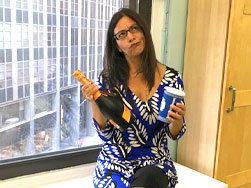
If you’re looking to write better copy, I hope you possess patience. Because that’s really what it takes: patience and a thesaurus. Here’s how those two things combine to make you a better writer.
First, what do I mean by “copy?” For the purposes of this post, I mean the broadest possible definition of the word: quite simply, any text in any form. This includes ads, social media posts, email messages to colleagues, texts to friends, cover letters for job applications, and much more. Literally ANY text.
Second, here’s a fact about writing: shorter is always more effective because attention spans are limited. What do I mean by “shorter?” I mean using the fewest words possible to articulate your point. Many folks set out to articulate their point. But they don’t also strive for doing it in the shortest possible way. Achieving both of those two goals simultaneously is neither quick nor simple.
I do NOT mean that your overall copy length can’t be long. Heck, Harry Potter and the Order of the Phoenix is 870 pages long and I was glued to that book until the very last word. But that actually proves my point. J.K. Rowling is a master at descriptive, precise writing that evokes imagery with the fewest words possible. 870 pages from her doesn’t feel tedious. Were she not such a master at this, it likely would have taken more than 1,000 pages to tell the same story, and THAT would be tedious.
The point is…you could zip through writing copy without investing the time to precisely articulate your words in the shortest possible way. Maybe you used three sentences to communicate something that could have been said in one sentence. Or you used a four-word-phrase instead of a single word because it came to mind first.
If you write your copy that way, here’s what you’re doing: you’re putting the burden of time on the reader to sift through all the extra words to arrive at your point. That likely matters less when you’re texting with a friend about your favorite TV show. It matters a LOT when you’re trying to persuade a reader to do/think/feel something.
So, especially if you’re in marketing, you need to be the one who assumes the burden of time in writing. The more time you take to make each piece of written communication shorter AND effective, the less time the reader is forced to invest in embracing your point. If you make it too cumbersome for them, they’ll just tune out or move on long before your point has been embraced.
That’s where my advice of “patience and a thesaurus” comes in.
Nouns and verbs all have connotations. These nuances give additional descriptive power to a single word by *slightly* altering the feeling/imagery it evokes. For example, there are 44 different words in thesaurus.com to describe something as “difficult.” So if you’re using that word in writing… do you mean – say – ambitious, problematic, arduous, immense, or challenging? All of those words could be classified under the heading of “difficult,” but each one also nods to the reason why something is difficult. And therefore, each one tells a different story.
And that’s the secret right there. You need to employ patience and a thesaurus to identify words that – by their very connotation – help you articulate the story you’re trying to tell.
Here’s an example I see a lot in the tourism marketing strategy work we do. A lot of organizations use the term “boundaries” or “parameters” in conjunction with big plans, projects, and initiatives. Those terms are meant to describe guidance given as the work proceeds to prevent straying from the plan.
But it’s possible in many cases that what the organization really means to describe are “guard rails.” Boundaries and parameters imply limits and fences around the whole project, whereas guard rails connote a limitless, unobstructed path with some assistance to keep things moving forward.
Figuring out whether boundaries, parameters, or guard rails tells the appropriate story just takes patience to think it through and, if necessary, a thesaurus check for more precise options.
In a more marketing-oriented example, look how the connotation of the experience you’ll have differs depending on the verb chosen:
- You’ll be amazed by your experience.
- You’ll be delighted by your experience.
- You’ll be inspired by your experience.
- You’ll be transformed by your experience.
- You’ll be tickled by your experience.
- You’ll be giddy from your experience.
- You’ll be left breathless by your experience.
- You’ll be hypnotized by your experience.
- You’ll be enchanted by your experience.
- You’ll be moved by your experience.
All of those are far more descriptive than saying “you’ll have a great experience.” That’s because “great” tells no descriptive story other than having a vague positive connotation. I call it an empty word, and you can see why you should stop using it here.
You can also find four really great powerful tips to strengthen your writing here.
Even the word “better” in this blog post’s headline isn’t an ideal word choice. “Better” is a nondescript, vague term that could benefit from a more descriptive upgrade. In this case, it could be: Write more persuasive copy. Or write more effective copy. Or write more descriptive copy. Or compelling. Or potent. Or -ooooohh – how about irresistible? There’s something delicious about evoking the vibe that your copy is something people can’t resist reading.
But alas…this is a blog post. And “better” is a more appropriate choice to match searcher intent (not many folks are searching for “how to write irresistible copy”). SEO writing is a whole different ballgame, so if that’s your goal, you should also check out these tips.
 get travel marketing tips
get travel marketing tips 














